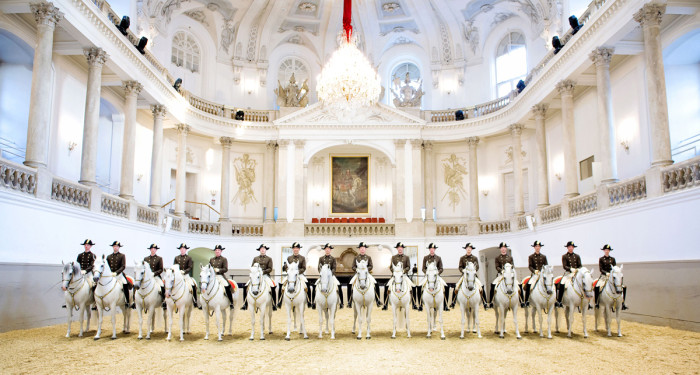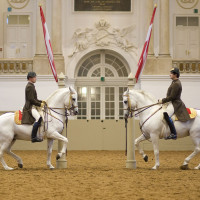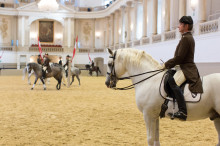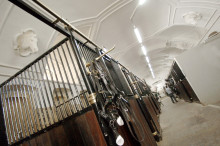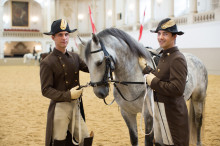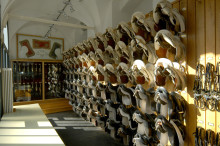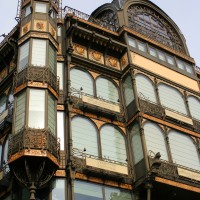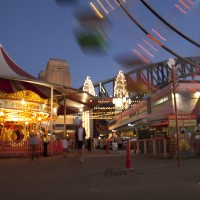With a history that dates back over 400 years, The Spanish Riding School in Vienna is the oldest classical dressage riding school in the world. Each of the famous Lipizzaner horses – Europe’s oldest breed of horse – train here for six years (riders train for 12 years) before they graduate to perform in the remarkable School Quadrille showcase of their work.
The school’s “Spanish” name comes from the School’s famous Lipizzaner stallions, which are Berber and Arabian stallions crossbred with Spanish Iberian mares. In the course of training, each stallion learns the piaffe (trotting in the one spot, so that it looks almost suspended in motion), the passage (an elevated trot with diagonal front/back legs lifted simultaneously), pirouettes (circling around with hind legs at the centre of a circle) and how to change legs midway through a canter. Just a few very talented stallions master the “Schools above the Ground” training, which includes the levade (controlled lifting of the forelegs off the ground), courgette (a series of ‘hopping’ style jumps), and the capriole (leaping into the air and kicking with the back legs).
However, the School’s status as a Viennese cultural icon is not simply due to the horses that feature here; the School’s two main buildings, The Stallburg and the Winter Riding School, are among Vienna’s most significant architectural features – which is saying a lot in a city that is itself a UNESCO World Heritage Site.
The Stallburg, on Reitschulgasse, is where the School’s Lipizzaners are stabled. Often referred to as Vienna’s most prominent Renaissance building, the “Maximiliansburg” (as the Stallburg is also called) was originally intended to become the official residence of Maximilian II, however when he ascended the throne in 1564 the building was not ready and he moved into the old Imperial Palace instead. In 2007, outdoor boxes were added in the Stallburg’s inner courtyard. From here the stallions can watch the hustle and bustle in the courtyard – and vice versa.
The Riding School building itself dates back to 1729 when Emperor Charles VI commissioned Josef Emanuel Fischer von Erlach to build this baroque riding hall in the Hofburg Palace. Completed in 1735, it was used for numerous carousels, masked balls, jousts and court festivities by Maria Theresa when she ascended the throne in 1740.
These days, approximately half of the School’s 72 stallions are regularly put through their paces in Morning Exercises, as observed by some 300,000 visitors annually. Be warned, the Morning Exercises are not much more than a matter of the beautiful horses doing paces around the ring to the muted sound of Strauss.
Whilst a performance is the ideal way to experience the horsemanship and training of the Lipizzaner stallions, Morning Exercises are often the only feasible option
None of the dramatic jumps are rehearsed during Morning Exercises; at best you’ll get to watch a few piaffes and passages, but mostly just walking and trotting. Even so, the experience does offer some insight into what this institution is all about. On the other hand, the Riding School’s amazing performances are expensive and, more importantly, often hard to time with a visit to Vienna – there are only a handful of performances each month and some months the School’s touring schedule mean there are no performances available in Vienna itself.
MORNING EXERCISES Approximately half of the horses are put through their paces each morning in 30 minute routines where horses and trainers do simple exercises designed to practise moves and refine choreographies. There’s nothing too impressive at these daily rituals – no classical jumps or ‘performance’ techniques being rehearsed, only walking, trotting, and the like.
PERFORMANCES During performances you get to see a series of different skills, from the first series of training exercises with horses in early training through to the spectacular perfection of the “High School of Classical Horsemanship” with the Pas de Deux, Work in Hand and on the Long Rein. The final 20 minutes is usually dedicated to the School Quadrille with eight stallions performing magnificent choreography. The Levade, Courbette and Capriole are the highlights of the “Schools above the Ground”. In 2014, one of the featured performances is the Tribute To Vienna which sees the Spanish Riding School performing with the Vienna Boys Choir, combining two Viennese institutions into one remarkable performance. Children under the age of 3 are not allowed to attend performances. According to some experienced viewers, the best seats is to buy are Category 2 seats in the first row of the first Galerie (seats 1, 2 or 3 or seats 166, 167, or 168). From these seats you can see down the length of the School.
GUIDED TOURS Take a visit to the Baroque Winter Riding School, the Summer Riding School as well as the Renaissance Stallburg ‘stables’ and learn about the history of the buildings, the equestrian traditions as well as the stories behind the Lipizzaner stallions. The tour takes one hour. Children under 3 are not permitted. Wheelchair access is not available.
Why go… The horses are beautiful, it’s a cultural icon, and it is housed in two of Vienna’s architectural gems.
Who is it best for… Children ages seven plus. The official policy is that children under the age of three are not admitted to either performances or daily exercise, although this doesn’t seem to be strictly monitored. However older children will probably appreciate the restrained atmosphere more than pre-schoolers.
Top tip… Forget the 09.30am start and head over at around 10.30 instead. You can buy tickets any time between 09.30 and 12.00, and around 45 minutes is probably about the right length of stay for the morning exercises. Going earlier might mean a front row seat, but the downside is the queue. If you arrive later, a little patience will land you a seat anyway. End result – you are queueing for a seat while you watch the horses instead of simply queueing.
Our favourite bit… It’s so much more exciting when the horses don’t do what they are supposed to than when they do. And whenever the training teams swap over – about once every 15 minutes – it’s exciting to see the new talent and temperaments coming through the door.
Don’t go… Expecting a performance at the Morning Exercise. It really is just that – morning exercise, which consists of a bit of a walk around the sandy floor of the magnificent Winter Riding Hall.
Clever Clogs Kids A portrait of which monarch graces the splendid Winter Riding School Hall?

